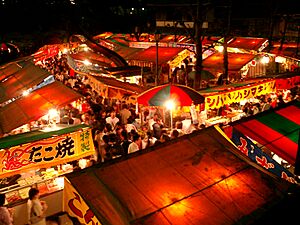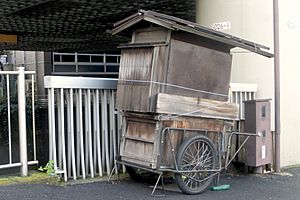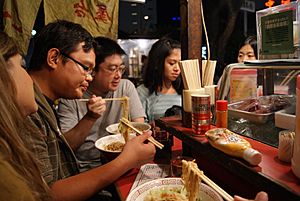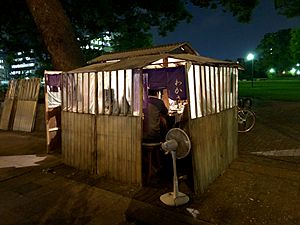Yatai (food cart) facts for kids
A yatai (屋台) is a small, mobile food stand in Japan. These stands usually sell tasty Japanese foods like ramen. The word yatai means "shop stand" in Japanese.
You can often see yatai setting up in the early evening on sidewalks. They pack up late at night or in the early morning.
Mobile food stands have been around since the 1600s. Yatai became very popular during the Meiji period (1868–1912). Back then, they were wooden carts with two wheels. They were also popular after World War II. However, rules were made before the 1964 Tokyo Olympics due to health worries. Today, yatai are mostly found in Fukuoka, but their numbers are still getting smaller.
Contents
What are Yatai Carts Like?
Yatai are usually wooden carts with wheels. They have kitchen tools and places for people to sit. The handles and seats can fold into the cart when it's being moved. A typical yatai cart is about 3 meters long and 2.5 meters wide.
Vendors at yatai sell many different foods. You can find traditional Japanese cuisine like ramen, gyoza (dumplings), and tempura (fried seafood and vegetables). They also often sell drinks like beer, sake, and shōchū. These carts usually open after the sun sets and close in the early morning.
The Story of Yatai
Yatai selling soba noodles were around as early as the 1600s. Big cities like Tokyo had thousands of them. People started talking about yatai in the way we know them today around 1710.
Yatai came from food stalls that were set up outside Buddhist temples a very long time ago. A historian named Hiroaki Ichikawa says that today's yatai started during the Edo period. During this time, important people often traveled between the capital and their homes. Yatai offered them a simple way to get food while traveling.
Yatai became popular again in the 1900s. This was when Japan was becoming more industrial, which led to less rice being available. Many farmers moved to the cities. Some people worried that yatai were changing traditional Japanese food culture.
Yatai were often found where there were many factory workers. Some yatai were even run by people from other countries, like Taiwan and Korea, who were living in Japan. After Japan lost World War II in 1945, yatai grew in number as Japan rebuilt its economy. Many of these stands operated without official permission. At that time, yatai often sold gyoza (dumplings) with lots of garlic, which people thought made them more filling. In the 1950s, companies started selling "ready-made" yatai carts. This helped make yatai more common.
As Japan's economy grew, many yatai turned into regular restaurants. This is how some famous ramen chains, like Harugiya Ramen in Tokyo, got their start. However, city officials became concerned about health issues with these traveling food stands. Before the 1964 Summer Olympics, new rules were made, which caused the number of yatai to go down.
In the 1970s, the media sometimes showed yatai as a romantic escape from the stress of work. They featured stories of business people who left their office jobs to run yatai. Some experts believe this was because Japanese men had few other choices for independent work at the time.
Yatai in Fukuoka Prefecture
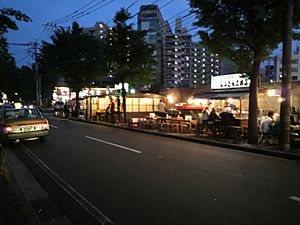
Today, the main places to find yatai are the Nakasu and Tenjin areas in Fukuoka City. When rules for yatai were made across Japan, yatai owners in Fukuoka formed a group. This helped them avoid many of the new rules.
While the number of yatai has gone down in most big cities, it stayed steady in the early 2000s. This was partly because Japan's economy slowed down, and yatai were a low-cost business option. Still, in Fukuoka, the number of carts has dropped from 450 in the 1960s to about 100 by 2018. A rule from 1994 said that a yatai license could only be passed to a direct family member, or the stand had to close. However, Fukuoka has made these rules less strict. In 2019, they even offered 14 new licenses.
Yatai in Kumamoto Prefecture
In Kumamoto Prefecture, which is just south of Fukuoka, there is only one yatai left in Kumamoto City. It's called Wakaki (わかき). This yatai holds the very last license in the prefecture. When its owner retires, the yatai culture in Kumamoto will end. The owner serves oden (a type of hot pot) and different drinks. She has many regular customers and also welcomes visitors from other countries. She often jokes that her restaurant has the most expensive toilet in Kumamoto. This is because customers use a public toilet in a nearby park, which cost a lot of money to build.
Yatai in Japanese Culture
In 1933, Satomura Kinzo wrote a short story about a yatai owner. It was called "Chronicle of Starting a Shina Soba Shop." The story showed the struggles of working-class people and the tough financial life of yatai operators back then.
The fancy floats you see in some Japanese festivals, like the Takayama Festival, are also called yatai. Unlike most festival floats that people carry, these are decorated carts with wheels. Some even have detailed mechanical puppets that perform during the parade. For the rest of the year, some of these floats are shown in the town's festival float museum, called the Yatai Kaikan (屋台会館).


